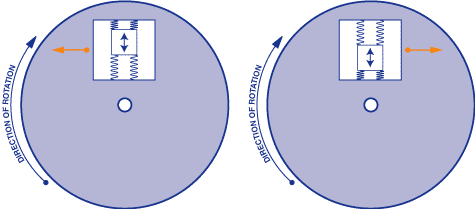Gyroscopes or gyros are devices that measure or maintain rotational motion. MEMS gyros (microelectromechanical system) are small low-cost sensors that measure angular velocity. The units of angular velocity are measured in degrees per second (° / s) or revolutions per second (RPS). Angular velocity is simply a measurement of rotational speed.

Gyroscopes, similar to the above, can be used to determine orientation and are found in most autonomous navigation systems. For example, if you want to balance a robot, a gyroscope can be used to measure rotation from the balanced position and send corrections to a motor.
How does a gyroscope work?
When things rotate about an axis, they have what is called angular velocity. A rotating wheel can be measured in revolutions per second (RPS) or degrees per second (° / s).

Note that the z-axis of the underlying gyroscope is aligned with the rotation axis of the wheel.

If you connect the sensor to the wheel shown above, you can measure the angular velocity of the z-axis of the gyro. The other two axes would not measure rotation.
Imagine the wheel spinning once per second. It would have an angular velocity of 360 degrees per second. The direction of rotation of the wheel is also important. Is it clockwise around the axis or is it counterclockwise?
A three-axis MEMS gyroscope, similar to the one pictured above (ITG-3200), can measure rotation about three axes: x, y, and z. Some gyros come in single-axis and dual-axis varieties, but the three-axis gyroscope in a single chip is smaller, less expensive, and more popular.
Gyroscopes are often used with objects that do not rotate very fast. Airplanes (hopefully) do not rotate. Instead, they rotate a few degrees on each axis. By detecting these small changes, gyros help stabilize the aircraft's flight. Also note that the acceleration or linear velocity of the aircraft does not affect the gyro's measurement. Gyros only measure angular velocity.
How does the MEMS gyroscope measure angular velocity?

The gyroscope sensor in the MEMS is tiny (between 1 and 100 microns, the size of a human hair). When the gyroscope is rotated, a small resonant mass is displaced as the angular velocity changes. This motion is converted into very weak electrical signals that can be amplified and read by a host microcontroller.
How to choose the right gyroscope
There are many specifications to consider when choosing which sensor to use. Here are some of the most important:
- The measurement range, or total scale range, is the maximum angular velocity the gyroscope can read. Think about what you are measuring. Do you need to measure the spin of a turntable that is very slow, or a spinning wheel that might be very fast?
- Sensitivity is measured in mV per degree per second (mV / ° / s). Do not be frightened by the strange dimension of this value. It determines how much the voltage changes for a given angular velocity. For example, if you specify a gyro with a sensitivity of 30 mV / ° / s and the output is changed by 300 mV, you have rotated the gyro by 10 ° / s. A good rule to keep in mind: As the sensitivity increases, the range decreases. For example, look at the data sheet of the LPY503 gyro.
- Bias: As with any sensor, the values you measure will contain some error or deviation. You can detect the gyro's tilt by measuring the output when the gyro is still stationary. Although you would think you would see 0 ° when the gyro is still stationary, there will always be a small non-zero error in the output. These errors are sometimes referred to as bias drift or bias instability. The temperature of the sensor greatly affects the bias. To minimize the source of error, most gyros have a built-in temperature sensor. This allows you to read the temperature of the sensor and correct for temperature-dependent changes. To correct for these errors, the gyro must be calibrated. This is usually done by holding the sensor still and setting all readings in your code to zero.
What is the difference between a gyroscope and an accelerometer?
The main difference between the two devices is simple: one can sense rotation, the other cannot. In a sense, the accelerometer can measure the orientation of a stationary object with respect to the Earth's surface. When accelerating in a particular direction, the accelerometer cannot distinguish between acceleration and acceleration due to gravity. If you consider this handicap when using it in an aircraft, the accelerometer quickly loses its appeal.
The gyro maintains its effectiveness by being able to measure the rate of rotation about a given axis. When measuring the rate of rotation about the roll axis of an aircraft, it determines an actual value until the object stabilizes. Following the basic principles of angular momentum, the gyroscope helps determine orientation. In comparison, the accelerometer measures linear acceleration based on vibration.
The typical dual-axis accelerometer gives users the direction of gravity in an airplane, smartphone, car, or other device. In comparison, a gyroscope is designed to determine an angular position based on the principle of spatial rigidity. Despite their similar purpose, the applications of each device vary widely. For example, a gyroscope is used in navigation on unmanned aerial vehicles, compasses and large boats, which ultimately contributes to the stability of navigation. Accelerometers are just as widely used and can be found in mechanical engineering, machine building, hardware monitoring, building and structure monitoring, navigation, transportation, and even consumer electronics.
>>> In our online store we offer a wide range of gyroscopes for sale!


